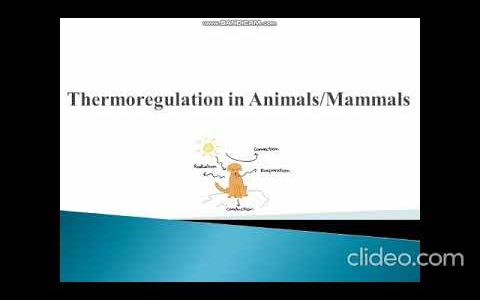F.Sc Part 2nd. Biology
THERMOREGULATION IN MAMMALS (HUMAN)
Regulatory Strategies
Mammals including human maintain their high body temperature within a narrow range of about 36-38 °C because of their endothermic characteristics. The origin of endothermy in birds and mammals have provided the opportunity to keep high metabolic rate and availability of energy round the clock, thus has acquired greater ability to adaptations and has assisted in much of their wider diversity and distribution in diversified regions of the earth. These regulate the rate of metabolic heat production, balancing it with the rate at which they gain or lose heat from the surroundings. The rate of heat production is increased by increased muscle contraction by movements or shivering so called as shivering thermogenesis. Also hormones trigger the heat production as do thyroid hormones and are termed as non-shivering thermogenesis. Some mammals possess brown fat, which is specialized for rapid heat production. In overproduction of heat it is dissipated through exposed surfaces by increasing blood low or the evaporative cooling. In mammals, it is observed that skin has been adapted as the organ of thermoregulation. (Fig. 15.14)
In Cold Temperature : Mammals have various mechanisms that regulate heat exchange with their environment. Vasodilation and vasoconstriction effect heat exchange and may contribute to regional temperature differences with in an animal. On a cool day a human’s temperature may be several degrees lower in the arms and legs than in the trunk, where the most vital glands are situated. Most land mammals respond to cold by raising their furs thereby trapping the thicker layer of still air and it acts as good insulator between animal skin and the surroundings. Human mostly rely on a layer of fat just insulating beneath the skin as insulating material against heat loss. Similarly marine mammals such as whales and seals inhabit much colder water than their body temperature, have a very thick layer of insulating fat called as blubber just under the skin.
31
15. Homeostasis eLearn.Punjab
Fig. 15.14 The thermostat function of the hypothalamus and feed back control mechanisms in human thermoregulation.
32
15. Homeostasis eLearn.Punjab
In Warm Temperature : Marine mammals dispose of their excess heat into warm seas by large number of blood vessels in the outer layer of the skin. This dissipates the heat from the skin surface. In terrestrial mammals, in contrast is the mechanism of evaporative cooling. The sweat gland activity and the evaporative cooling is the one of the major temperature reducing strategies. Panting, the evaporative cooling in the respiratory tract, is the other mechanism as represented in the dogs. Bats etc use saliva and urine for evaporative cooling.
Thermostat Function and Feedback Controls in Human
The body temperature regulation in humans is based on complex homeostatic systems facilitated by feedback mechanisms. The homeostatic thermostat is present in the hypothalamus, a brain part. It responds to the changes in the temperature above and below a set point which is 37°C.
In case of increase in temperature above the set point, certain warm temperature sensitive thermoreceptors in skin, hypothalamus and other parts of nervous systems send the signals to the system that increase the blood low to the skin and also cause sweat gland activation and the sweat is evaporated for the cooling.
In cold temperature, the cold receptors send the impulses to hypothalamus to inhibit heat loss mechanisms and activate the heat conservation mechanisms. This includes constriction of superficial blood vessels and stimulating shivering and non shivering mechanisms.
Temperature in fever (Pyrexia)
In bacterial and viral infections mainly, leukocytes increase in number. These pathogens and the blood cells produce chemicals called as pyrogens. Pyrogens displace the set point of hypothalamus above the normal point of 37° C. Fever or high temperature helps in stimulating .the protective mechanisms against the pathogens
source
Thermoregulation in Mammals | Strategies in Cold & Hot | Thermostat Function | Chapter: Homeostasis



